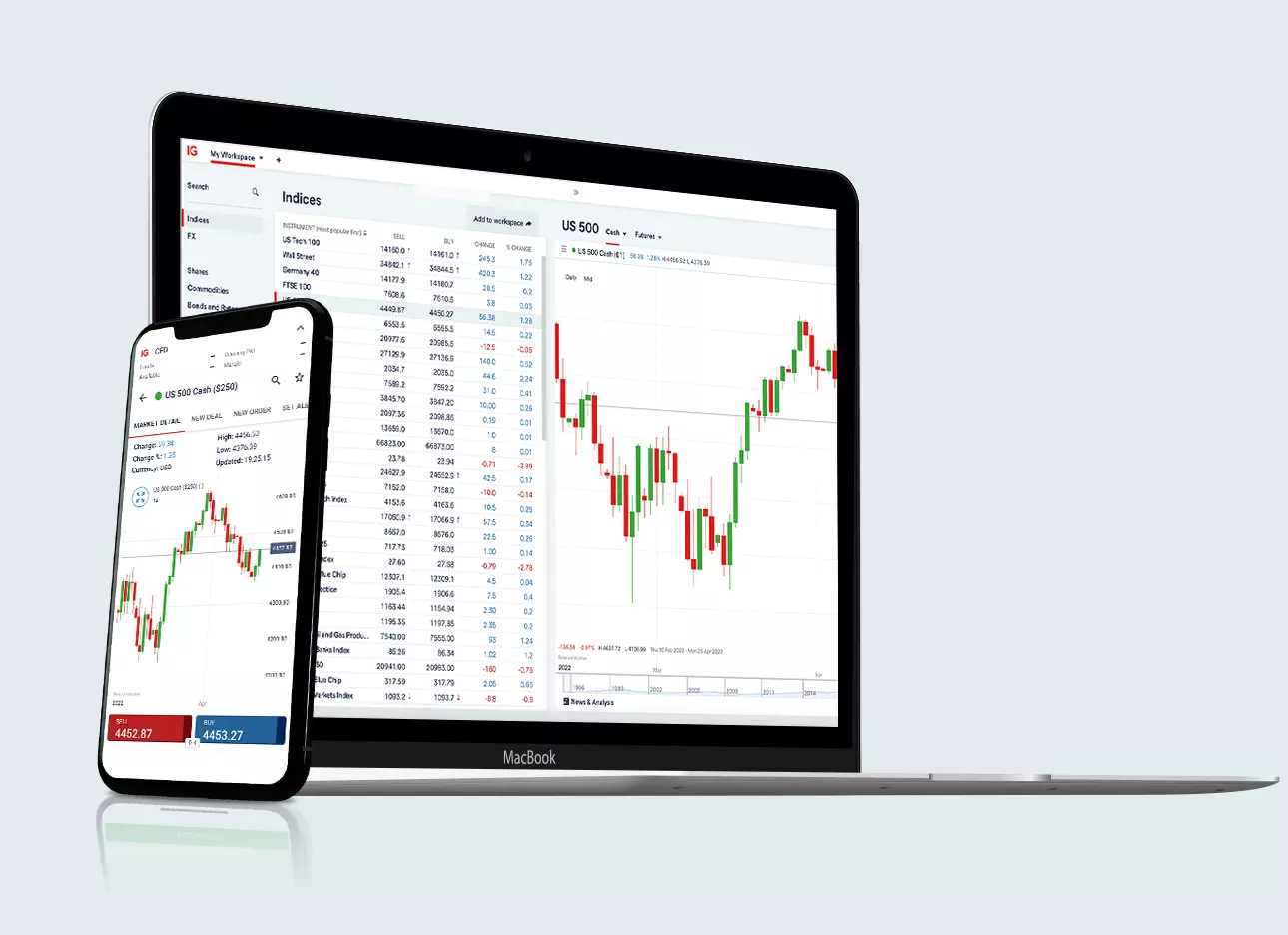How to trade the Hang Seng Index
The Hang Seng Index lists some of Hong Kong’s biggest companies. Learn how you can get exposure to Hang Seng shares, ETFs and more via our Hong Kong HS50 index.

You can get exposure to the Hang Seng Index via our Hong Kong HS50 index. To open a position, follow these three steps:
1. Decide how you’d like to trade the index
You can harness the power of the Hang Seng Index by trading in HS50 ETFs and individual shares, or trading on the index’s value.
2. Create a trading plan
Before taking a position on the HS50, you'll need to decide whether you're a short- or mid-term trader – and how to manage your risk.
3. Open a live account
Create and fund your contract for difference (CFD) trading account – start by filling in our application form.
To help you decide how to trade the Hang Seng Index (HSI) via the HS50, we explain each method in detail below.
How can you trade the Hang Seng Index?
You can trade the Hang Seng Index (HSI) via our Hong Kong HS50 offering, which tracks the price of the underlying index.
You can:
- Trade the HS50 price directly
- Trade Hang Seng Index-related ETFs
- Trade Hang Seng Index-listed shares
Trade the HS50 price directly
Take a position on the HS50, which tracks the Hang Seng Index, using CFDs. Although these are derivative trading products, this is the most direct way to trade on the price of the underlying index – the HSI
- Gain exposure to the HSI in a market with high liquidity
- Enjoy the freedom to go ‘long’ (if you think the price will rise) or ‘short’ (if you think the price will fall)
- Spread charges apply to CFDs (except share CFDs).
- Use our HS50 ‘cash’ (spot) market to take a position in the short term
- Choose our HS50 futures or options markets for longer-term positions
- Trade around the clock, 24 hours a day1.
Trade Hang Seng Index-related ETFs
- Gain broad exposure to the HSI with our related ETFs
- Take a position on Hang Seng Index-tracking ETF price movements with CFDs without owning the underlying asset
- Use CFDs to go long or short – but remember that this offers lower liquidity and higher spreads than trading the HS50 price directly via CFDs
- Instead of taking a position the current index level of the HS50, you can trade on the price of the Hang Seng Index-linked ETF – calculated using the fund’s net asset value (NAV)
Trade Hang Seng Index-listed shares
- Target specific stocks included in the Hang Seng Index without trading the entire index
- Take a position on Hang Seng Index-listed stock price movements with CFDs without owning the underlying asset
- Go long if you think share prices will go up, or short if you think they’ll go down
- CFD share trades incur a minimum of HKD100 commission charge
|
Trading the HS50 price directly | Trade Hang Seng Index-related ETFs | Trading Hang Seng Index-listed shares |
Account types |
CFD trading account |
CFD trading account |
CFD trading account |
Market hours |
24 hours a day1 |
US-listed HS50 ETFs can be traded when the US exchange is opened between 10.30pm to 5am Monday to Thursday and 10.30pm on Friday to 5am on Saturday (Singapore time). |
When the Hong Kong Stock Exchange is open – 9.30am to 4pm (Singapore time), Monday to Friday. |
Timeframe |
Short to medium term |
Short to medium term |
Short to medium term |
Liquidity and execution |
0.0107 second execution speed* and unique deep liquidity |
Higher liquidity offered by trading the HS50 price directly |
Higher liquidity offered by trading the HS50 price directly |
Costs |
Trading the HS50 on the spot (cash) incurs overnight fees, but index futures don’t incur these fees |
CFD cash (spot) ETF trades incur overnight fees and have a minimum commission of $15 |
Trade in Hong Kong shares using CFDs for 0.25% of total trade size – min commission is HKD100. |
* Correct as of 1 February 2022. Average speed calculated from 1 to 28 February 2022.
Overnight funding fees are charged on cash index, share and ETF positions held open after 10pm UK time (international times may vary). These fees are not charged on futures and options2.
How to start trading the Hong Kong HS50
Open a CFD trading account
Using our platform, you can trade the Hang Seng Index with a CFD trading account.
With CFDs, you'll trade on leverage without having to own any actual shares. Instead, you’ll put down a deposit to open a larger position, with profits and losses calculated on the full position size. Leverage means both profit and loss will be magnified to value of the full trade – so you could gain or lose money faster than you’d expect. Remember to take steps to manage your risk.
When trading CFDs you can:
- Predict the price of stocks, ETFs and index prices rising or falling
- Leverage your exposure – you’ll only pay a deposit to get exposure to the full position size
- Take shorter-term positions
- Look to hedge your portfolio when trading
- Trade without owning the underlying asset
Because you don’t own the underlying asset, you won’t have any shareholder privileges.
Learn what moves the HS50 index’s price
- Economic events – given the proximity to China and the large number of Chinese companies dominating the HS50, one can expect the economic and political backdrop in the country (including trade wars) to play the key role in the index’s price movements
- News – reports surrounding worldwide events, such as the 2019 coronavirus outbreak, can have a significant impact on the price of the index
- Earnings reports – when constituents of the Hang Seng release their earnings reports, it’s important to note if there are any big changes to each company’s market capitalisation. If so, and the company has significant weight in the HS50, it can sway the index’s price
- Interest rate decisions – generally, when interest rates go down, markets tend to rise and when interest rates go up, the market reacts negatively. This can also be true for the HS50, but it is not a guarantee. Stay abreast of interest rate decisions by major central banks as it can cause some short-term volatility in the market
- Currency rates and fluctuations – the strength of currencies, such as HKD, CHD and JPY, have a direct impact on the performance of the companies within the HS50. This is because the constituents do business with countries across the world, which means their income is dependent on various exchange rates. If these rates fluctuate often, the index’s price will also be affected
Hone your HS50 trading strategy
Here are a few tips to consider as you develop your HS50 trading strategy:
- Choose your trading style: decide how you want to trade the index by choosing a trading style based on your risk appetite and how much time you have available. There are four trading styles, suited to different types of traders
- Examine charts and price action: use CFDs on HS50 price charts to assist in determining market sentiment. Knowing how to use charts when trading can help you to estimate what the index price might do next
- Conduct technical analysis and indicators: learn how technical analysis and trading indicators can help you to identify chart patterns, trading signals and trends in the markets
- Set trading alerts: set criteria for the CFDs on HS50 and get notified when the criteria are met. This way, you can trade instantly if you think the market has reached the right price
Take your first HS50 trading position
Let’s take a more detailed look at the various ways you can open a position via CFD trading.
A contract for difference (CFD) is an agreement to exchange the difference in price of an underlying asset, as measured from the time the contract is opened until the time it’s closed.
The difference between the open and closing price of the underlying asset is your profit or loss (depending on whether your prediction is correct or incorrect).
You can trade CFDs on HS50 via:
- Cash indices: predict the current price of the underlying market and get tighter spreads. Short-term traders prefer this method
- Index futures: agree to trade the index at a predetermined price on a date in future. Longer-term traders prefer this method
- Options: buy the right (but not the obligation) to trade the index at a specified price in future. Experienced traders with a longer-term view typically prefer this method
- ETFs: trade all Hang Seng Index-related stocks, on the spot, in a single position
- Shares: make a prediction on Hang Seng Index-listed shares’ prices rising or falling without owning them
Here’s an example of how CFD trading works. Say you believe that the HS50 cash index is set to rise from its current price of 20,000. So, you buy 10 CFD contracts on our index worth S$5 per contract. Your prediction is correct, and you close your position when the sell price is 20,090. The difference is 90 points, multiplied by the S$5 per contract multiplied by 10 contracts, so your profit is S$4500 – excluding other costs.
If your prediction is incorrect and the market drops, and you closed your trade at a level of 19,950, your loss would be S$2500 – excluding other costs.

FAQs
What are the ways you can trade the Hang Seng Index?
You can trade using CFDs to take a position on the cash index, options, ETFs and shares.
What should you know before trading the Hong Kong HS50?
Before trading on Hong Kong HS50, do your research and understand how the index works – how it’s calculated and what affects it price. Then, decide how you want to trade the index.
Try out our demo platform or open a trading account if you’re ready to take on the live markets.
How do companies get onto the Hang Seng Index?
Constituent stocks must be among the top 90% of the total turnover on the Stock Exchange of Hong Kong (SEHK) and have a listing history of at least two years. The index is calculated in real-time at two-second intervals during the trading hours of the exchange. The 50 companies that qualify are listed on the Hang Seng Index, traded via the HS50 on our platform.
What are the HS50 trading hours?
The Hang Seng index trades between 23.02 Sunday and 22.15 Friday (London time) each week. This will be between 07.02 Monday and 06.15 Saturday (Singapore time) on non-Daylight Savings periods and between 06.02 Monday and 05.15 Saturday (Singapore time) during Daylight Saving periods.
Develop your knowledge of financial markets
Find out more about a range of markets and test yourself with IG Academy’s online courses.

Try these next
See how you can react to volatility in the markets
Discover how to trade with free online courses, webinars and seminars
A step-by-step guide on how to trade CFDs
1 Indices are available for dealing 24 hours a day, between 23.02 Sunday and 22.15 Friday (London time) each week. This will be between 07.02 Monday and 06.15 Saturday (Singapore time) on non-Daylight Savings periods and between 06.02 Monday and 05.15 Saturday (Singapore time) during Daylight Saving periods. Other indices are offered only when the underlying market is open. Please ask dealers for information about public holidays.
2 Overnight funding is the charge you pay for keeping cash CFD trades open past 10pm UK time (intrnational times may vary); we’ll make an interest adjustment to your account to reflect the cost of funding your position. Learn more about how overnight funding is calculated.
